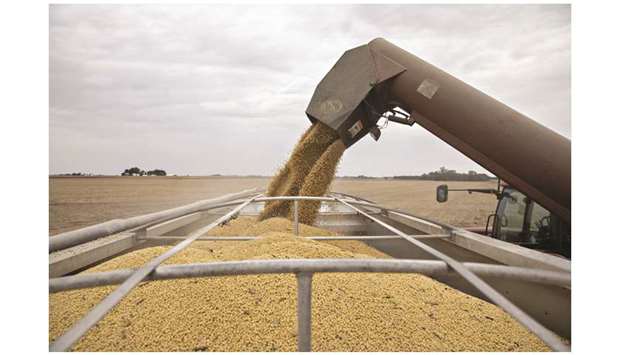US farmers may return to pre-trade war levels of sales to China in time for the presidential election year, relieving economic pressure on one of Donald Trump’s key political constituencies as he campaigns for a second term and fights an impeachment inquiry.
But the bonanza of $40bn to $50bn in annual agricultural sales to China that Trump promoted when he announced a tentative partial trade deal on October 11 will almost certainly have to wait until after the presidential vote, if it ever comes.
And China’s added purchases also come with strings attached.
China aims to buy at least $20bn of agricultural products in a year if it signs a partial trade deal with the US, and would consider boosting purchases further in future rounds of talks, people familiar with the matter said.
That would take China’s imports of US farm goods back to around 2017 levels, before Trump began a tit-for-tat tariff feud with Beijing.
In the second year of a potential final deal, purchases could rise to $40bn to $50bn.
But that would depend on Trump removing remaining punitive tariffs, said the people, who asked not to be named because talks are private.
On a call between the two sides scheduled for Friday, Beijing is expected to ask the US to remove tariffs imposed on September 1 and cancel the tariff hike scheduled for December, two US-based people briefed on the talks told Reuters.
If a deal can be done, Beijing would exempt some US agricultural products from tariffs, a China-based source told Reuters.
Trump already has raised expectations that he and Chinese President Xi Jinping will sign a phase-one deal when they meet in Chile next month.
Chinese officials also have said talks are progressing.
The signal from China on first-year purchases provides a clearer picture on the deal taking shape.
When trade talks wrapped up in Washington on October 11, Trump said China would lift agriculture purchases to between $40bn and $50bn.
The people didn’t say when the first year would start or when China would begin counting imports toward the $20bn.
The two nations are working on details of a limited agreement, after talks in Washington earlier this month at which the US agreed not to hike tariffs in October, and said China agreed to increase purchases and other concessions.
US Trade Representative Robert Lighthizer, Treasury Secretary Steven Mnuchin and Chinese Vice Premier Liu He are scheduled to speak by phone on Friday as they try to get a deal down on paper.
US Commerce Secretary Wilbur Ross said any agreement on contentious structural issues will wait for two additional phases. China’s Ministry of Commerce didn’t immediately respond to a fax seeking comment on agricultural purchases.
While in 2017 China’s $20bn agricultural purchases was heavily weighted toward soybeans, the nation’s need for meat is now greater because an outbreak of African swine fever has devastated its hog herd and sent pork prices soaring.
“The bottom line is that China’s history tells us that it will buy what it needs to buy – to meet domestic needs or political needs – and no more or no less, regardless of the commitments that it makes,” FCStone said in the note.
US agricultural groups maintained a cautious stance toward the potential partial deal.
“We are still in the same position we were in a couple of weeks ago when news of the partial agreement was first announced, where we need confirmed details to adequately respond,” said Wendy Brannen, a spokeswoman for the American Soybean Association.
“China is struggling with food price inflation and needs reliable sources of pork,” said Jim Monroe, a spokesman for the National Pork Producers Council.
We continue to seek the permanent removal of punitive tariffs on US meat so we can address this important need in China.” China has already started ramping up purchases to lay the groundwork for the signing of a phase-one deal.
Beijing issued waivers for 10mn metric tonnes of soybean purchases this week.
It’s considering approving an additional 4mn to 5mn tonnes of grains, including wheat, corn and sorghum, according to people familiar.
Data out of the US Department of Agriculture was a mixed bag.
Sales of US soybeans to China slumped in the week ended October 17.
However, the USDA separately announced a daily sale of 264,000 tonnes of US soybeans to China.

Soybeans are unloaded from a harvester in Illinois. China aims to buy at least $20bn of agricultural products in a year if it signs a partial trade deal with the US, and would consider boosting purchases further in future rounds of talks, people familiar with the matter said.
